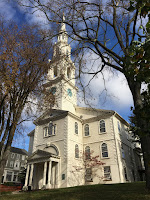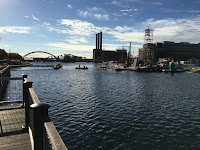This blog is about places - or at least is place-based. So not much seems to happen when I'm not going to new (or interesting) places. Occasionally, glimpses of more routine stuff creeps in, but even then, it only happens when I have photos that I like. I dabble with photo journals of the places we eat, the places I drink coffee (
Emerald City Coffee), and even the covers of books I read, but those are simply records of events - not excuses to develop content (whether substantive or not).
The previous entry was from Boise, on the last morning of our trip. A week later (mid-September), 35 miles into a ride around Lake Washington, I tried to see what would happen if I turned the front wheel sharply while at the same time hitting a large speed bump in the road. What happens, apparently, is that it pretty much rules out bike rides or late September hikes in the mountains. Time on the computer is spent shopping for new bike helmets and paying radiologists rather than posting pictures of places I didn't get to.

But I digress. Last week - now late October and fully recovered from my experiment in middle-aged ballistics - I spent four days at the Geological Society Meeting meeting in Seattle. The weather was wonderful and I took advantage of it by walking down to the Market a couple of times for lunch. I love the new "front porch" which looks out over the sound and anticipates the rapidly approaching absence of the viaduct. I also love Storyville Coffee's location above the market. Like so much of Seattle's food scene, it's all about presentation and an excess of disposable income, but I'm a sucker for aesthetics and sun shining in through large semicircular windows. It makes $10 for a latte and a cookie
almost make sense!
I don't get to hang out with geologists much in my job, so the meeting was a lot of fun. I enjoy my regular company of ecologists and land use planners, but they just don't share the geologist's appreciation for geographic jig saw puzzles and their twisted sense of long periods of time.
I went to talks on Puget Sound earthquakes, BC landslides, Lake Michigan bluffs, Martian shorelines, and of course, the giant floods on the Columbia Plateau. I learned how the volcanic record of the Pacific Northwest records the post-subduction history (50M years) of the remnants of the subducted Farallon Plate. I heard about the history of hydraulic fracturing in petroleum production and about advances in multispectral remote sensing. Maybe the coolest talk was the description of the Hell's Creek formation in North Dakota, where the Cretaceous-Tertiary boundary is recorded as a jumbled layer of rocks and dead fish fossils, some of which still have tektites (small spherical stones generated by the heat and pressure of the impact) in their gills.



















































